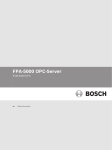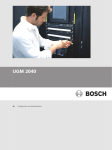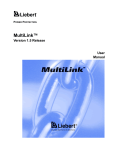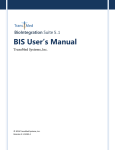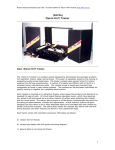Download Bosch FPA-5000 User guide
Transcript
FPA-5000 OPC-Server FSM-5000-OPC en User Guide FPA-5000 OPC-Server Table of Contents | en 3 Table of contents 1 Purpose 4 2 Preconditions 6 3 Installation 7 3.1 Installation of FSM-5000-OPC Software 7 3.2 Remote Access to the FSM-5000-OPC Server from the Building Integration System (BIS) 7 3.3 Backward Compatibility 9 3.3.1 Package: BIS600StateConversion.msi 9 3.3.2 Package: LanguageDependentCommand.msi 4 Step-by-Step Configuration 10 4.1 FSP-5000-RPS 10 4.2 Panel Controller MPC-xxxx-B or MPC-xxxx-C 11 4.3 PC/Server 11 5 Troubleshooting 12 6 Technical data 13 7 Appendices 15 7.1 Appendix A.1 - State Table 1 15 7.2 Appendix A.2 - State Table 2 17 Bosch Sicherheitssysteme GmbH User Guide 9 2013/05 | 2.0 | F.01U.261.550 4 1 en | Purpose FPA-5000 OPC-Server Purpose This document contains information on accessing and controlling FPA-5000 networks via OPC using the FSM-5000-OPC server. It is designed to aid in successfully configuring the FPA-5000 network and the corresponding FSM-5000-OPC server to enable communication between the two via a single or redundant Ethernet connection. In completing these steps successfully a functional interface is provided for a subsequent connection to BIS 2.x which functions as OPC client. Notice! Setting up and configuring an FPA-5000 network controlled by an OPC server requires basic IT knowledge. The information refers to FSM-5000-OPC Version 1.1.11 and later and supported FPA-5000 software. 192.168.1.2 255.255.255.0 Cat. 5 Cat. 5 Ethernet FPA_OPC RSN 004 CAN RSN 001 RSN 002 RSN 003 RSN 003 Figure 1.1: FPA-5000 network controlled by an OPC server with single Ethernet connection 2013/05 | 2.0 | F.01U.261.550 User Guide Bosch Sicherheitssysteme GmbH FPA-5000 OPC-Server Purpose | en 5 192.168.1.2 255.255.255.0 Cat. 5 Cat. 5 Ethernet FPA_OPC RSN 004 switch CAN RSN 001 RSN 002 RSN 001 RSN 003 RSN 003 Figure 1.2: FPA-5000 network controlled by an OPC server with redundant panel Bosch Sicherheitssysteme GmbH User Guide 2013/05 | 2.0 | F.01U.261.550 6 2 en | Preconditions FPA-5000 OPC-Server Preconditions The following must be available to set up an OPC server in an FPA-5000 network: – FPA-5000 network with MPC-xxxx-B or MPC-xxxx-C – ADC-5000-OPC license card – Latest FSP-5000-RPS installation CD – The correct FSM-5000-OPC Server version for the respective FPA-5000 release (available on FSP-5000-RPS installation CD or download from Extranet). Look up the compatible version in the readme file of the FSM-5000-OPC software. – Existing Ethernet network with Cat. 5e cable – PC to install FSM-5000-OPC on 2013/05 | 2.0 | F.01U.261.550 User Guide Bosch Sicherheitssysteme GmbH FPA-5000 OPC-Server Installation | en 3 Installation 3.1 Installation of FSM-5000-OPC Software 7 Task: FSM-5000-OPC is running on a PC. Notice! .NET Framework 2.0 must be installed to run FSM-5000-OPC. If it is not present install it from the Pre-Requisites folder of the FSP-5000-RPS installation CD or download it from http:// www.microsoft.com/downloads/en/default.aspx 1. On the setup disc open the folder that contains the FSM-5000-OPC installation. 2. Click “FPA5000OPCServer.msi” and follow the installation instructions. 3. Open the Configuration Editor: Start → All Programs → Bosch → FPA5000OPC-Server and run Configuration Editor or open Windows Explorer, navigate to C:\Program Files\Bosch\FPA 5000OPC-Server and run ConfigEditor.exe or for FSM-5000-OPC version 1.2 right click on the respective icon in the taskbar notification area and choose “Configuration”. 4. Under the “Communications“ tab adopt the settings that were entered for the node “FPA5000 OPC Server” in the RPS configuration. 5. Configure the Windows firewall. The configuration depends on the operating system and 6. Restart the system. the used firewall. FSM-5000-OPC will be running after restart, indicated by a notification icon in the taskbar notification area. Notice! The installation of FSM-5000-OPC is only released for the Windows operating systems listed in Technical data, page 13. For other operating systems the installation may succeed but was not tested and is therefore on your own risk. 3.2 Remote Access to the FSM-5000-OPC Server from the Building Integration System (BIS) Task: FSM-5000-OPC is running on a PC in your local network interconnected with the panel network. The OPC client application runs on a PC of the Building Integration System (BIS) in the same local network. It remotely accesses the FSM-5000-OPC server. Server side PC Notice! Consider the naming conventions for users, groups and passwords (“MgtS-Service” “BISUsers“) given in this description. The Building Integration System (BIS) internally makes use of these conventions. As BIS internally always assumes the same user and password by convention it is not necessary to logon as a distinct user or enter the password. If you remotely access the FSM-5000-OPC server with another client, you are free to choose names and a password on the server side, as long as you specify the matching logon when your client connects to the OPC server. Bosch Sicherheitssysteme GmbH User Guide 2013/05 | 2.0 | F.01U.261.550 8 en | Installation FPA-5000 OPC-Server All of the following settings refer to the PC running the OPC server. Notice! The following steps are based on the Windows XP operating system. For all other operating systems the paths to the respective dialogs might be slightly different. Create user „MgtS-Service“ manually 1. Go to Start – Settings – Control Panel – Administrative Tools – Computer Management – Local Users and Groups – Users and enter the following values: 2. – Username (case sensitive): "MgtS-Service" – Password: Please contact BIS customer support if it is the BIS client you are using. – Member of group: Administrators – User must change password at next logon: NO – User cannot change password: YES – Password never expires: YES Tab Local Security Settings: – Log on as a service: YES – Log on as a batch job: YES Notice! The user name and password must be identical with the user of the login server. Create group BISUsers manually 1. Go to Start – Settings – Control Panel – Administrative Tools – Computer Management – Local Users and Groups – Groups and enter the following value: – Group name (case sensitive): "BISUsers" 2. Add the user “MgtS-Service” to that group 3. Add the user who logs in from the operating system of the login server and who operates the ConfigurationBrowser to that group too. DCOM-Settings for the group BISUsers 1. Click Start > Run.... 2. Type dcomcnfg <ENTER>. 3. Open the tree on the left side: Console Root > Component Services > Computers > My Computer. 4. Right click on My Computer and choose Properties. 5. Choose the COM Security tab. 6. Add the new group “BISUsers” by using Access Permissions – Edit Defaults – allow Local and Remote Access. 7. Add the new group “BISUsers” by using Launch and Activation Permissions – Edit Defaults – allow Local and Remote Launch and allow Local and Remote Activation. 8. Add the new group “BISUsers” by using Launch and Activation Permissions – Edit Limits – allow Local and Remote Launch and allow Local and Remote Activation. 9. Reboot the PC. Set Local Security Policy Perform the following procedure to set the Local Security Policy. For operating systems Windows XP / Windows Server 2003 / Windows 7 / Windows Server 2008: 1. Go to Start - Control Panel - Administrative Tools, and select Local Security Policy. 2. Open the tree on the left side: Security Settings - Local Policies- Security Options. 2013/05 | 2.0 | F.01U.261.550 User Guide Bosch Sicherheitssysteme GmbH FPA-5000 OPC-Server Installation | en 9 3. Select on the right side: Network access: Sharing and security model for local accounts. 4. Right click on this selection to open Properties and choose Classic– local users authenticate as themselves. 5. Close all windows and restart the PC. 6. Open dcomcnfg and go to services (Local). 7. Select FPA5000OPCServer - Properties and open the Log-On tab 8. Choose radio button This Account – User: MgtS-Service and the password. 9. You are requested to restart the service in order to activate the changes. Select Stop and Start (or Restart). Client side PC On the PC running the FSM-5000-OPC client software connect to the server with the same logon you used to start the service. This also applies if you install both on the same PC. The OPC server installation routine installs the service for the local system account by default. Change the service to “MgtS-Service” when you use the OPC server with BIS. 3.3 Backward Compatibility There are two setup packages to provide backward compatibility. To install the respective file 1. Go to the Compatibility folder on the setup disk 2. Double click the respective msi-file Notice! Only use these packages if you require compatibility with solutions designed for versions prior to version 1.1 of FSM-5000-OPC server. 3.3.1 Package: BIS600StateConversion.msi Description: States of the OPC server mapped to an offset of 600 instead of line status designed for backward compatibility of OPC Server version 1.1 with older clients. For instance configurations read by BIS 1.0.x requires it in order to work with the 1.1.x OPC Server. Precondition: OPC Server ≥ 1.1.x installed. Postcondition: Registry entry for OPC configuration set. 3.3.2 Package: LanguageDependentCommand.msi Description: The commands are language dependent like OPC Server 1.0.x. Designed for backward compatibility of OPC Server version 1.1 with older clients. For instance configurations read by BIS 1.0.x requires it in order to work with the 1.1.x OPC Server. Precondition: OPC Server ≥ 1.1.x installed Postcondition: Registry entry for OPC configuration set. Bosch Sicherheitssysteme GmbH User Guide 2013/05 | 2.0 | F.01U.261.550 10 en | Step-by-Step Configuration FPA-5000 OPC-Server 4 Step-by-Step Configuration 4.1 FSP-5000-RPS 1. Open the FSP-5000-RPS programming software. 2. In an existing 2.x configuration select “Nodes” in the tree view and choose “Create FPA-5000 OPC- Server” in the context menu. A new node with name FPA-5000 OPC-Server is created and a dialog box for configuration is opened. 3. Configure the OPC server node. Enter the virtual RSN and logical node. 4. Choose IP Settings... to enter the IP settings dialog. 5. Edit the fields accordingly. IP Address and Subnet Mask are mandatory fields, Gateway is optional. Notice! The settings must match the network adapter/card settings of the computer the FSM-5000OPC Server will be installed on! The values of Net Group and Node Address, the RSN and the IP address are required to configure the OPC server. 6. Confirm your changes with OK and leave the dialog. 7. Double-click on the FPA-5000 panel node that will be physically connected to the Ethernet. A dialog box for configuration opens. 8. Choose IP Settings... to enter the IP settings dialog. 9. Edit the fields accordingly. Panels not directly connected to the Ethernet are not assigned an IP address. 10. Confirm your changes with OK and leave the dialog. 11. Double-click on the “FPA-5000” node, e.g. “FPA 5000 – 1.1 – RSN A dialog box for FPA-5000 additional configuration opens 12. Select OPC Server under a vacant Inserted address card(s) field. Notice! It is mandatory that this FPA-5000 node is then assigned to the OPC server! 13. Choose the country and the language from the list Notice! Take care about the country and language settings. BIS 2.x will display commands and detector names in the selected language. 14. Confirm your settings with OK and leave the dialog. 15. Double click on Assigned servers. A dialog box opens. 16. Assign the panel to the OPC server. Repeat this task for each node that is to transmit its states to the OPC server. 17. Confirm your changes with OK and leave the dialog. 2013/05 | 2.0 | F.01U.261.550 User Guide Bosch Sicherheitssysteme GmbH FPA-5000 OPC-Server 4.2 Step-by-Step Configuration | en 11 Panel Controller MPC-xxxx-B or MPC-xxxx-C 1. Insert the ADC-5000-OPC card into one of the vacant address card slots. 2. Go to the node that has been assigned an IP address and connect the Cat.-5 cable to the MPC‑xxxx‑B or MPC‑xxxx‑C “Ethernet” port (RJ45). 4.3 PC/Server 1. Connect the Cat.-5 cable to the PC Ethernet port. Afterwards open the DOS command window and successfully “ping” the panel controller. 2. Right click on the OPC icon in the taskbar notification area and open the Connection dialog. A list with all identified panels and their respective connection status is displayed. If the configuration was successful, all panels which are assigned to the OPC server should have the status “connected”. You can also find these information in a log file, located on C:\Program Files\Bosch \FPA5000 OPC-Server\Log (for Windows XP, might be slightly different for other operating systems). Bosch Sicherheitssysteme GmbH User Guide 2013/05 | 2.0 | F.01U.261.550 12 5 en | Troubleshooting FPA-5000 OPC-Server Troubleshooting If the configuration of the FSM-5000-OPC server doesn’t work with the FPA-5000 network try the following: – Confirm on the panel controller that the IP address is assigned and “ping” the OPC server. – If the Ping request is answered but the configuration still doesn’t work please check – all settings on the panel, – all settings in the FSM-5000-OPC Configuration Editor, – the Ethernet adapter settings in the Window’s System Configuration. – De-activate firewall – Follow these steps: – – Stop OPC (see “Service” tab in Configuration Editor) – Delete bin file(s) under C:\MPOPCServer\Repository – Start OPC → A new file per node will be created. If no elements are shown, check whether the Repository folder exists and whether it contains a bin file for each node. The files are located under C:\MPOPCServer\Repository. – On the MPC panel controller go to Diagnostics – Network – Routing table. A table with routing information is displayed. All networked nodes that can be reached via the panel and that are recognized within the system network are displayed under Node. Aside the respective interfaces via which the connected network nodes are connected to the panel are displayed. If the OPC server configuration is correct there must be an entry under Node with the RSN of the OPC server node and the interface “UDP tunnel”. – Make sure that the panel controller does not show any troubles which could concern the OPC server node or the network communication in general. – Verify that OPC card is detected by panel: Choose in the start menu of the panel controller: Diagnostics - Hardware - Address cards 2013/05 | 2.0 | F.01U.261.550 User Guide Bosch Sicherheitssysteme GmbH FPA-5000 OPC-Server Technical data | en 13 Technical data 6 Supported OPC standards: – DA 2.0 – AE 1.01 Other Standards – “BIS Common Requirements” (Bosch standard). Supported operating systems: – Windows XP Professional – Windows 2003 Server 32-bit – Windows 2008 Server 64-bit – Windows 2008 Server R2 64-bit – Windows 7 32-bit – Windows 7 64-bit Limits For each panel approximately 2000 OPC items can be created in maximum configuration. Memory For configuration data caching a file with approximately 200kb is stored for each panel in the repository folder. Licensing Each OPC Server requires an OPC license card (ADC-5000-OPC) in one of the assigned FPA-5000 panels. Additional Information LAN Technology Specifications: IEEE Standard Name Data Rate Media Type Maximum Distance Ethernet 802.3 10 Mbps 10Base-T 100 meters Fast Ethernet/ 8ß2.3u 100 Mbps 100Base-TX 100 meters 2000 100Base-FX meters 1000Base-T 100 meters 1000Base-SX 275/550 meters 1000Base-LX 550/5000 meters 10GBase-SR 300 meters 10GBase-LX4 300m MMF/ 10km 10GBase-LR/ER SMF 10GBase- 10km/40km SW/LW/EW 300m/10km/40km 100Base-T Gigabit Ethernet/ 802.3z 1000 Mbps GigE 10 Gigabit IEEE 802.3ae 10 Gbps Ethernet Guide to Ethernet Coding 10 at the beginning means the network operates at 10Mbps. BASE means the type of signaling used is baseband. 2 or 5 at the end indicates the maximum cable length in meters. T at the end stands for twisted-pair cable. Bosch Sicherheitssysteme GmbH User Guide 2013/05 | 2.0 | F.01U.261.550 14 en | Technical data FPA-5000 OPC-Server X at the end stands for full duplex-capable cable. FL at the end stands for fiber optic cable. For example: 100BASE-TX indicates a Fast Ethernet connection (100 Mbps) that uses a twisted pair cable capable of full-duplex transmissions. Cable Grade Capabilities Cable Name Makeup Frequency Data Rate Support Cat-5 Cat-5e 4 twisted pairs of Network Compatibility 100 MHz Up to 1000Mbps ATM, Token Ring, copper wire -- 1000Base-T, terminated by 100Base-TX, RJ45 connectors 10Base-T 4 twisted pairs of 100 MHz Up to 1000Mbps 10Base-T, copper wire -- 100Base-TX, terminated by 1000Base-T RJ45 connectors Cat-6 4 twisted pairs of 250 MHz 1000Mbps 10Base-T, copper wire -- 100Base-TX, terminated by 1000Base-T RJ45 connectors 2013/05 | 2.0 | F.01U.261.550 User Guide Bosch Sicherheitssysteme GmbH FPA-5000 OPC-Server Appendices | en 7 Appendices 7.1 Appendix A.1 - State Table 1 OPC Item Value Internal Panel 15 Description Compound State 600 Invalid 601 Normal 602 Fault 603 Fire 604 Fire Pre 1st state AND / Cross zoning 605 Fire verify Alarm Verification 606 Heat 607 Supervisory 608 Smoke 609 Activate 610 Activation failed 611 Tamper 612 Cover open Cover is open 613 Paper out Paper is out 614 Threshhold Alarm 1st stage fire, threshold 615 Trouble light Light trouble, e.g. C-Sensor of a combined detector Supervisory Error not working 616 Panel Restart by Panel restarted by watchdog Watchdog 617 On 618 Off 619 Pollution 620 Pollution light 621 Monitor 622 Water 623 Power Fail 624 Manual Alarm 625 Fire PAS PAS (Wait for acknowledge) 626 Fire PAS PAS (Investigate) 627 Address card change Address card changed Bosch Sicherheitssysteme GmbH User Guide 2013/05 | 2.0 | F.01U.261.550 16 en | Appendices FPA-5000 OPC-Server 628 629 Not enough address Address card changed and now there are less space addresses licensed than points configured Address card tamper The countdown after address card removal is finished, addresses are to be switched off 630 Fire internal Internal fire, results from a usage type “FIRE_INT” 631 Error Indicates an invalid value for a logical state since INVALID is used elsewhere in the system 632 Unknown For state stor use only 633 internal use Wild card 634 Configuration Mismatch of network configuration (topology mismatch information) 635 Unknown item Unconfigured item i.e. network node detected 636 Missing Configured item i.e. network node NOT detected, for internal items currently trouble used 637 638 Incompatible Incompatible software detected for nodes in software network Incompatible network Incompatible network protocol version detected for protocol nodes in network 639 internal use 640 internal use 641 Walktest Normal 642 Walktest Fault 643 Walktest Activate 644 Walktest Activation failed 645 Walktest On 646 Walktest Off 647 Walktest Alarm 648 Bypass Normal 649 Bypass Fault 650 Bypass Activate 651 Bypass Isolated Activation failed 652 Bypass Alarm 653 Isolate Normal 654 Isolate Fault 655 Isolate Activate 2013/05 | 2.0 | F.01U.261.550 User Guide Bosch Sicherheitssysteme GmbH FPA-5000 OPC-Server Appendices | en 656 17 Isolate Activation failed 657 Isolate Alarm 658 Normal Day Mode 659 Fault Day Mode 660 Alarm Day Mode Table 7.1: Appendix A.1 - State Table 1 7.2 Appendix A.2 - State Table 2 OPC Item Value Description LZ Name 0 Missing Zone FG 1 Detector masking MAD 2 Fade-out/Skip ABL 3 Zone switch off ABS 4 Detector test TST 5 Stand-by/Control off GE 6 Breakdonw centr. part G8 7 Control On STE 8 Malfunction ground ES 9 Criterion -4 K4 10 Criterion -3 K3 11 Criterion -2 K2 12 Malfunction generic G0 13 Emergency alarm H1 14 Int-Fire F3 15 Pre-Fire F2 16 Ext-Fire (TU) F1 17 Trigger disarmed A6 18 Intern-Alarm A5 19 Int-Sabotage A4 20 Ext-Sabotage (TU) A3 21 Ext-Intrusion (TU) A2 22 Hold-up Alarm (TU) A1 23 Ext-Malfunction.(TU)/Ext-Fire. (TU) A0 24 Stand-by/Off PE Bosch Sicherheitssysteme GmbH User Guide 2013/05 | 2.0 | F.01U.261.550 18 en | Appendices FPA-5000 OPC-Server 25 On P2 26 Acknowledgement P3 27 Malfunction P4 28 Malfunction power supply P5 29 Switch Off P6 30 Alarm verification TEL 31 Address Blocking ASP 32 Triggering generic R-FG 33 Maint.-Stand-by OMM R-GE 34 Maint.-Light Pollution R-G0 35 Maint.-Heavy Pollution R-G2 36 Maint.-Alarm OMM R-AL 37 Maint.-Stand-by/Control Off R-GE 38 Maint.-Breakdown Centr. Part R-G8 39 Maint.-Control On R-STE 40 Maint.-Malfunction Ground R-ES 41 Maint.-Criterion-4 R-K4 42 Maint.-Criterion -3 R-K3 43 Maint.-Criterion -2 R-K2 44 Maint.-Malfunction R-G0 45 Maint.-Emergency Alarm R-H1 46 Maint.-Int-Fire R-F3 47 Maint.-Pre-Fire R-F2 48 Maint.-Ext-Fire R-F1 49 Maint.-Triggering R-A6 50 Maint.-Intern Alarm R-A5 51 Maint.-Alarm Thermo (UGM) R-A4 52 Maint.-Alarm Optics (UGM) R-A3 53 Maint.-Ext-Intrusion (UGM) R-A2 54 Pollution (UGM) R-A1 55 Maint.-Malfunction-Ext R-A0 56 Stand-by R-R/Max (UGM) R-PE 57 Stand-by ThermoMax (UGM) R-P2 58 Stand-by Optics (UGM) R-P3 2013/05 | 2.0 | F.01U.261.550 User Guide Bosch Sicherheitssysteme GmbH FPA-5000 OPC-Server Appendices | en 59 Alarm Pre-Level (UGM) R-P4 60 Fire-Int Thermo (UGM) R-P5 61 Fire-Int Optics (UGM) R-P6 62 Fire-Ext Thermo (UGM) R-TEL 63 Fire-Ext Optics (UGM) R-ASP 64 Stand-by R-R/Max GE-TD 65 Stand-by TMax GE-TM 66 Stand-by Optics GE-O 67 Stand-by Combi GE-K 68 Light Pollution V2 69 Heavy Pollution V1 70 Heavy Pollution (Qty.) V0 71 Alarm Pre-Level Ion AV-I 72 Alarm Pre-Level Optics AV-O 73 Alarm Pre-Level Thermo AV-T 74 Alarm Pre-Level Combi AV-K 75 Maint.-Alarm Optics R-F1-O 76 Maint.-Alarm Thermo R-F1-T 77 Maint.-Alarm Combi R-F1-K 78 Fire-Ext Opt F1-O 79 Fire-Ext Thermo F1-T 80 Fire-Ext Combi F1-K 81 Call Fire Brigade FWR 82 Fire-Pre (TU) F2-E 83 Fire-Int Opt F3-O 84 Fire-Int Therm F3-T 85 Fire-Int Combi F3-K 86 Hold-up alarm with menace (TU) A1-B 88 Stand-by Day/Internal T-GE 89 Periph. Control On P8 90 Light Malfunction G1 91 Line Malfunction G2 92 End of Paper PA 19 87 Bosch Sicherheitssysteme GmbH User Guide 2013/05 | 2.0 | F.01U.261.550 20 en | Appendices FPA-5000 OPC-Server 93 Triggering Disarmed A7 94 Mains Fault 95 Battery Fault Table 7.2: Appendix A.2 - State Table 2 2013/05 | 2.0 | F.01U.261.550 User Guide Bosch Sicherheitssysteme GmbH Bosch Sicherheitssysteme GmbH Robert-Bosch-Ring 5 85630 Grasbrunn Germany www.boschsecurity.com © Bosch Sicherheitssysteme GmbH, 2013






















